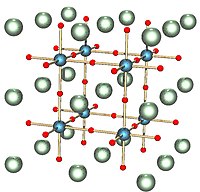
Photo from wikipedia
Hybrid perovskite materials are famous for their great application potential in photovoltaics and optoelectronics. Among them, lead-iodide-based perovskites receive great attention because of their good optical absorption ability and excellent… Click to show full abstract
Hybrid perovskite materials are famous for their great application potential in photovoltaics and optoelectronics. Among them, lead-iodide-based perovskites receive great attention because of their good optical absorption ability and excellent electrical transport properties. Although many believe the ferroelectric photovoltaic effect (FEPV) plays a crucial role for the high conversion efficiency, the ferroelectricity in CH3 NH3 PbI3 is still under debate, and obtaining ferroelectric lead iodide perovskites is still challenging. In order to avoid the randomness and blindness in the conventional method of searching for perovskite ferroelectrics, a design strategy of fluorine modification is developed. As a demonstration, a nonpolar lead iodide perovskite is modified and a new 2D fluorinated layered hybrid perovskite material of (4,4-difluorocyclohexylammonium)2 PbI4 , 1, is obtained, which possesses clear ferroelectricity with controllable spontaneous polarization. The direct bandgap of 2.38 eV with strong photoluminescence also guarantees the direct observation of polarization-induced FEPV. More importantly, the 2D structure and fluorination are also expected to achieve both good stability and charge transport properties. 1 is not only a 2D fluorinated lead iodide perovskite with confirmed ferroelectricity, but also a great platform for studying the effect of ferroelectricity and FEPV in the context of lead halide perovskite solar cells and other optoelectronic applications.
Journal Title: Advanced materials
Year Published: 2019
Link to full text (if available)
Share on Social Media: Sign Up to like & get
recommendations!